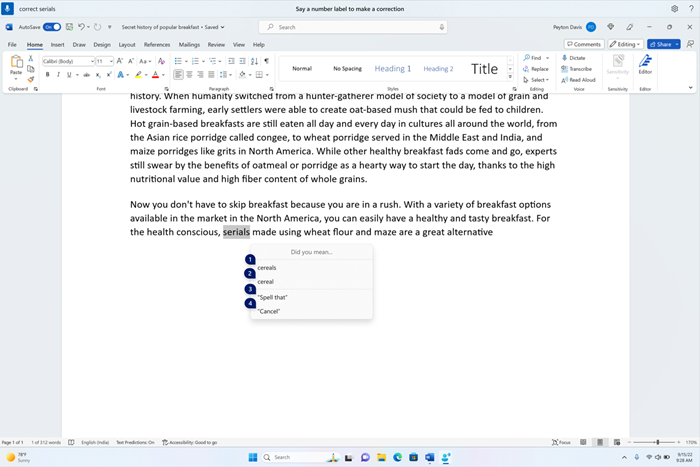This article is for people who want to control their PC and author text using their voice with Windows. This article is part of the Accessibility support for Windows content set where you can find more information on Windows accessibility features. For general help, visit Microsoft Support home.
Voice access might make mistakes in recognizing the text dictated by users. It might happen for words that sound similar such as 'cited, sighted', and 'sink, sync'. You can use correction commands to correct such words with voice access.
Voice access is a feature in Windows 11 that enables everyone to control their PC and author text using only their voice and without an internet connection. For example, you can open and switch between apps, browse the web, and read and author email using your voice. For more information, go to Use voice access to control your PC & author text with your voice.
Voice access is available in Windows 11, version 22H2 and later. For more information on Windows 11 22H2 new features, and how to get the update, see What's new in recent Windows updates. Not sure which version of Windows you have? See: Find Windows version.
Using correction commands
Correction commands can be used for correcting errors while using voice access.
-
To correct a specific text or last dictated text, say “Correct <text>” or “Correct that”. Voice access opens a correction window with a list of alternative text suggestions labeled with numbers.
-
To select any alternative text suggestion from the list, say “Click <number>”. The original text selected in the text box will be replaced by this alternative text.
-
To dictate the correct spelling of the text, say “Spell that” or “Click <number>” associated with the “Spell that” option in the list.
Note: To learn more about using the “Spell that” command, refer to 'Spell non-standard words' section in Dictate text with voice.
For example,
-
To correct the word “serials”, you can say “Correct serials” or “Select previous word”. Then, say “Correct that”.
-
A list of alternate suggestions with number labels will appear. You can say “Click 1” or “1” to select “cereals”.
|
To do this |
Say this |
|---|---|
|
Correct specific text in a text box |
“Correct <text>” |
|
Correct the selected text or last dictated text |
"Correct that" |
Tips:
-
For easy selection of the text to be corrected, use any selection command listed in the Select text with voice and then say, “Correct that”.
-
It is recommended to correct one word at a time. Correcting multiple words at once might not yield good alternate text suggestions.
See also
Technical support for customers with disabilities
Microsoft wants to provide the best possible experience for all our customers. If you have a disability or questions related to accessibility, please contact the Microsoft Disability Answer Desk for technical assistance. The Disability Answer Desk support team is trained in using many popular assistive technologies and can offer assistance in English, Spanish, French, and American Sign Language. Please go to the Microsoft Disability Answer Desk site to find out the contact details for your region.
If you are a government, commercial, or enterprise user, please contact the enterprise Disability Answer Desk.











